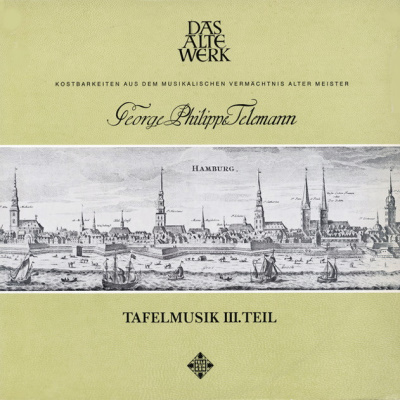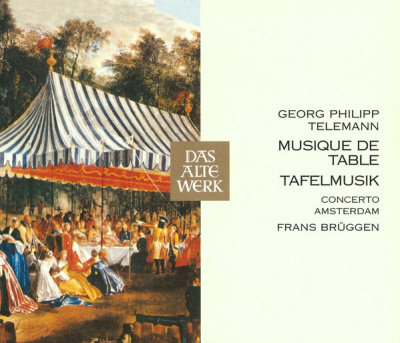 |
|
2 LPs
- SAWT 9453/54-A - (p) 1965
|
 |
| 2 LPs -
6.35064 DX (TK 11564/1-2) - (p) 1975 |
 |
| 6 LPs -
6.35298 FX - (p) 1976 |
 |
| 4 CDs -
0825646945726 - (c) 2014 |
|
TAFELMUSIK,
III. Teil
"Musique de Table partagée en Trois
Productions dont chacune contient I
Ouverture aver la suite à 7 instruments,
I Quatuor, I Concert à 7, I Trio, I
Solo, I Conclusion à 7 et dont les
instruments se diversifient par tout;
composée par Georg Philipp Teleman,
Maître de Chapelle de Lrs, As, Ss, le
Duc de Saxe.Eisenach, et le Marggrave de
Bayreuth; Directeur de la Musique à
Hambourg."
Originaltitel nach der
kupferstichausgabe von 1733.
|
|
|
|
|
|
|
|
| Georg Philipp
TELEMANN (1681-1767) |
Ouverture
B-dur - für zwei Oboen, Streicher
und Basso continuo |
|
22' 17" |
|
|
-
Lentement · Presto · Lentement
|
6' 00" |
|
A1
|
|
mit
Suite
|
|
|
|
|
- Bergerie (Un peu vivement)
|
2' 21" |
|
A2
|
|
-
Allegresse (Vite)
|
2' 26" |
|
A3 |
|
-
Postillons
|
2' 14" |
|
A4
|
|
-
Flaterie
|
2' 54" |
|
B1 |
|
-
Badinage (Très vite)
|
2' 42" |
|
B2 |
|
-
Menuet |
3' 40" |
|
B3 |
|
Quartett
e-moll - für Querflöte, Violine,
Violoncello und Basso continuo |
|
9' 15" |
|
|
-
Adagio
|
2' 07" |
|
B4 |
|
-
Allegro |
2' 04" |
|
B5 |
|
-
Dolce |
2' 45" |
|
B6 |
|
-
Allegro |
2' 19" |
|
B7 |
|
Konzert
Es-dur - für zwei Hörner, Streicher
und Basso continuo |
|
16' 22" |
|
|
-
Maestoso |
3' 03" |
|
C1 |
|
-
Allegro |
4' 58" |
|
C2 |
|
-
Grave |
3' 05" |
|
C3 |
|
-
Vivace |
5' 16" |
|
C4 |
|
Trio
D-dur - für zwei Querflöten und
Basso continuo |
|
9' 17" |
|
|
-
Andante |
2' 39" |
|
D1 |
|
-
Allegro |
2' 07" |
|
D2 |
|
-
Grave · Largo · Grave |
2' 26" |
|
D3 |
|
-
Vivace |
2' 05" |
|
D4 |
|
Solo
g-moll - für Oboe und Basso continuo |
|
11' 16" |
|
|
-
Largo |
2' 30" |
|
D5 |
|
-
Presto · Tempo giusto
|
4' 38" |
|
D6 |
|
-
Andante |
1' 15" |
|
D7 |
|
-
Allegro |
3' 13" |
|
D8 |
|
Conclusion
B-dur - für zwei Oboen, Streicher
und Basso continuo |
|
2' 00" |
|
|
-
Furioso
|
2' 00" |
|
D9 |
|
|
|
|
|
CONCERTO AMSTERDAM |
Frans
BRÜGGEN, Leitung
- Jaap Schröder, Konzertmeister
- Gustav Leonhardt, Cembalo
Solisten:
Ad Mater,
Lilian Lagaay, Oboe
Frans Vester, Joost Tromp,
Querflöte
Adriaan van Wounderberg, Hermann
Baumann, Horn
Jaap Schröder, Jacques
Holtman, Marie Leonhardt, Violine
Anner Bylsma, Violoncello
Brian Pollard, Fagott
Veronika Hampe, Gambe
Eugen M. Dombois, Theorbe
[Laute] |
|
|
|
|
|
Luogo
e data di registrazione |
|
Hervormde Kerk,
Bennebroek (The Netherland) -
16/21 Dicembre 1964 e 12/22
Gennaio 1965
|
|
|
Registrazione: live
/ studio |
|
studio |
|
|
Producer |
|
Wolf Erichson
|
|
|
Prima Edizione LP |
|
Telefunken "Das Alte
Werk" | SAWT 9453/54-A | 2 LPs -
durata 31' 32" - 38' 55" | (p)
1965 | ANA
Telefunken
| 6.35064 DX (TK 11564/1-2 | 2
LPs - durata 31' 32" - 38' 55" |
(p) 1975 | ANA | Riedizione
Telefunken |
6.35298 FX | 6 LPs - durata 252'
55" | (p) 1976 | ANA |
Riedizione (Produzioni I-II-III)
|
|
|
Edizione CD |
|
Warner Classics |
LC 06019 | 0825646945726 | 4 CDs
- durata 252' 55" | (c) 2014 |
ADD | (Produzioni I-II-III) |
|
|
Cover
|
|
-
|
|
|
Note |
|
-
|
|
|
|
|
The Third
"Production" is clearly
modelled on the first in its
character and form,
particularly in the Overture
and the Concerto, so that
the three large-scale
sections of the complete
work together form a
symmetrical grouping, just
as they are symmetrically
constructed in themselves.
The Overture -Suite in B
flat major (for two
oboes and strings) is in
seven movements, like that
the First Part, but its
"fashionable" character is
strengthened by the
inclusion of purely
programmatic pieces and the
use of modern character
designations in place of the
traditional French dance
titles for the individual
movements, except for the
opening Overture itself and
the final Minuet. The Overture
already seeks to modify the
French character of the
movment in the 'Lentement'
introduction by mixing the
traditional dotted rhythms
and dignified, rolling runs
with "Italian" mannerisms
(Lombardic rhythms), rustic
triplets, "sighing"
appoggiaturas and finally
(similarly to the Overture
of the second "Production")
a pastoral episode with
swaying wood-wind thirds
over sustained string chords
within the smallest space a
wealth of musical characters
and nuances of expression
that almost seems to brust
the characteristic form of
such an introduction as it
has come down to us. The
Presto that follows is again
a blending of fugue and
concerto as tried out so
often by Telemann in his
"Musique de Table". The free
fugato opening returns four
times in varied form as a
"concerto ritornello"; in
between there are
concertante episodes in
which the first violin in
particular is given an
important role to play. The
variety of instrumental
combinations in these solo
passages and the sturdy
dance character of the
movement contribute further
to the modification of the
usual style of the French
overture allegro. The
movement ends in customary
fashion with a varied
repetition of the Lentement
section. As in the Suite of
the first "Production", the
movements that now follow
are suite movements whose
character is modelled on
concerto structure, the solo
passages being played, as in
the Presto of the Overture,
by the oboes and the first
and second violin (mostly
without continuo). Their
basic mood is one of
harmless, rough-and-ready
enjoyment in which Telemann,
far removed from all courtly
bearing, gives free rein to
his predeliction for
folk-music and picturesque
tone-painting, for genre
music-making and for
powerful rhythmic effects.
Thus the "Bergerie" really
is an energetic "Shephrds'
Dance", with two extensive
solo episodes between three
ritornellos. Just as much in
folk-music style is the
"Allegresse", whose Trio is
extended into a big
concertante "Solo" for two
oboes, two violins and
'cello' without continuo.
The genre character of the
"Postillins" is quite
unmistakeably clear, this
merry piece of programme
music being built around a
stylized post-horn motif and
formally laid out like the
"Bergeries". In accordance
with its title, the
"Flaterie" is more
contemplative, gentle and
somewhat coquettish in its
effect; it transforms the
traditional Sarabande
character, still just
discernible, completely into
that of a characteristic
piece, and even introduces
tutti-solo contrasts within
the minute space of the
individual formal sections
of a suite movement. The
"Badinage", related not only
in title to the "Badinerie"
of Bach's B minor Suite, is
again full of humour and
vitality ("Très vite"), and
corresponds exactly to the
"Allegresse" in its form.
The suite ends with a
rustically energetic Minuet
(with a dance movement trio
played by the soloists
alone, as in the
"Allegresse" and the
"Badinage"). Handel, an
illustrious subscriber to
the original edition, made
considerable use of its
music; the introduction of
the Overture appears in the
corresponding section of the
Overture to "Hercules"
(1744), the Presto of the
Overture again in the
corresponding section of the
Overture to the "Occasional
Oratorio" (1746) and the
"Postillons" in the
programmatic Sinfonia in Act
II of "Belshazzar" (1744).
If this Suite can be called
"popular" in style, the Quartet
in E minor for flute,
violin, 'cello and continuo
can with equal justification
be called "erudite". This is
just as true of its overall
form, which consistently
follows the model of the
four-movement Church Sonata
in its sequence of movements
and their individual types,
as of its relatively strict
polyphony, which leaves but
little room for concertante
episodes but nevertheless
develops all the melodic and
rhythmic charm of which
Telemann's ingenuity was
capable, even in the most
demanding and artificial of
musical forms.
In the third "Production",
as in the first Concerto
(here in E flat major) is
not only the forman
centrepiece but also the
musical climax of this part
of the work, again
combining, as in the first
part, concerto principles
with suite movement forms in
the four movements of the
Church Sonata. Two solo
corni da caccia lend it the
unconventional colour and
character of a resplendent
and resounding piece of
hunting music. The
dignified, grand Maestoso
and above all the elegiac
Grave in C minor, with its
enchanting tone effects and
its rapturous, sensitive
melody in the solo violins,
introduce more serious
undertones into this basic
mood. The two quick
movements, however,
especially the Finale in
gigue style, bring the merry
character of hunting music
all the more into the
foreground. The D major Trio
Sonata for two flutes
and continuo that follows
this powerful work
corresponds to the
skillfully written E minor
Quartet only in its position
in the whole cycle, in its
"remote" key and in its
traditional four movements.
In its style and musical
language, on the other hand,
it is extremely "modern" in
effect, in the sense of
post-baroque, "sensitive"
stylistic character, created
by its rapturous, singing
melody with delicately
balanced periods in song
style, by the parallel
writing in thirds an sixths
for the two flutes, which
overgrows all stricter
techniques of part writing,
and by its simple bass
writing with frequent "drum"
effects. The Oboe Sonata
in G minor is, like
the other two solo sonatas
of the "Musique de Table", a
modest piece of "musique for
playing" that still clearly
recalls in its style those
baroque traditions which the
Trio Sonata had already left
far behind; by means of the
little "Tempo giusto" Minuet
in G major, which is
inserted after the second
movement, it extends the
form of the Church Sonata in
suite style. Finally, the
'Conclusion', with its tempo
indication "Furioso"
indicate of unusual things
to come, summarizes once
again the stylistic elements
of the three "Productions",
intensifying the mood of the
Suite and the Concerto in a
loosely constructed
interplay of fugue and
concerto techniques and
strains of hunting and
folk-music into a truly
"furious" finale. Handel
also recalled this
delightful charachteristic
piece re-creatively in the
Overture to "Samson" (1741)
and that to the "Occasional
Oratorio". But even without
such a "patent of nobility"
the piece, and with it the
entire "Musique de Table",
must be classed not only
among Telemann's best works,
but among the greatest of
all instrumental
compositions of the early
18th century.
Ludwig
Finscher
|
  |
|
|